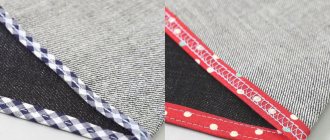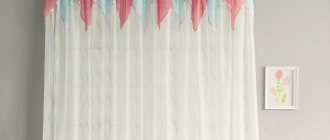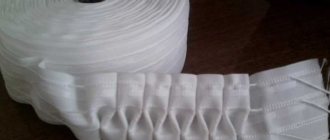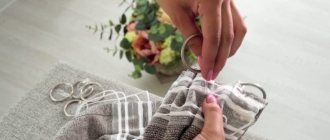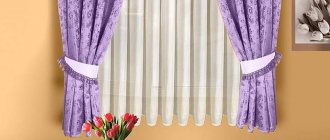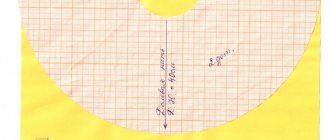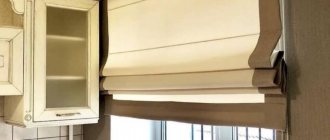Curtain tape serves as a kind of base for creating all types of folds. In its composition from the inside it has twisted ropes running lengthwise. The braid is sewn in two lines behind the top border of the curtains from the wrong side, after which the ropes are tightened.
To create beautiful folds, the curtain tape should not move in different directions, it should be strong.
The choice of suitable braid is responsible for the formation of folds of the required configuration. The gathering tape gives the folds and gathers the desired shape in a geometrically verified manner, distributing them over the entire length of the baguette at equal intervals.
Having a ribbon, drapery can be done by anyone, even those who have little knowledge of this type of work.
Tightening the curtain tape correctly is not difficult. The main thing is to know how it's done. We'll tell you about this.
Today a wide variety of curtain tapes are sold in different sizes.
The variety corresponds to its purpose. Tapes are:
- exclusively for hooks;
- with Velcro and loops for hooks;
- fasteners with Velcro for rigid lambrequin and fabric;
- for vertical fixation of Roman, French, London or Austrian curtains;
- for curtains with eyelets;
- under the strings;
- under the tubular cornice.
The tape is sewn to the back of the curtain; the number of seams depends on the number of laces.
For curtains, the most optimal is considered to be a durable tape, rather than one that moves in all directions. Before purchasing, try to assemble the ribbon in a certain area by pulling out the laces to do this. You can safely buy a product when the assemblies are firmly fixed during assembly. And, conversely, you should not buy a tape that forms shapeless and not entirely uniform folds. More often, the collection tape is attached to the edge of the curtain, sometimes retreating 2-5 centimeters from its edge. In the second case, when assembling the canvas, there remains a gap that can be used to cover the rings or cornice; they can provide the visibility of the curtains “from the ceiling.”
Related article: How a toilet works
The assembled ribbon with bows forms the gathers that are more formal in appearance. It is advisable to use it on frills, which are impractical to do on sliding products. Ribbons with puff pleats are also best used on non-retractable curtains; pulling the laces on such a ribbon will lead to the loss of the assembled pattern.
Hooks on curtains are appropriate only when there are simple folds. They are inserted into the pockets of the attached ribbon and into the rail cornices. Hooks are made of plastic for light curtains, and brass for heavier curtains. Special hooks are required for ribbons with bow pleats and triple pleats.
What is curtain tape and where can you see it?
Curtain tape or braid is a strip of a certain width made from a special polyester material. Its main function is to maintain the shape of the fabric during washing or when the curtains may become deformed under their own weight.
Curtain tape also has another important function - a cable is threaded through it, which will subsequently be secured to the cornice. To do this, a series of holes are made in the braid at the same distance from each other. The ribbon itself has practically no specific varieties, but a number of interesting draperies can be obtained from it. These may be the following models:
- Regular model. Just neat folds, the texture of which depends on the density of the material. For example, with denser fabrics, the folds take on a solid and “heavy” appearance, while with lighter fabrics, they become more delicate. Regular drapery is used most often.
- Models with counter folds. Suitable for curtains made of wool, where the material has a high density, but is not too rough. Making counter drapery is problematic, but then the curtains on the curtain tape take on an extremely attractive appearance.
- Bow ones. Suitable for celebrations, but look inappropriate for everyday use.
- Cylindrical shape. The folds of such drapery have an elongated shape. They are perfect for a regular apartment, office or any other office space.
How to hem tulle and sew curtain tape with your own hands
Selection of braid
When selecting, it is important to consider two points.
- For a heavy curtain, choose a thick braid. For easy ones it’s the other way around.
- The number of draped drapery laces depends on the width of the braid. The more there are, the more complex the drapery can be assembled.
The more drapery laces in the tulle, the more complex and frequent the drapery can be created. For easy gathering, two laces are enough. For translucent fabrics (including tulle), use a ribbon made from strong fishing line. “Heavy” fabric will not shine through very nicely through light fabric. A narrow one will attract less attention. Wide ones are intended for thicker curtain fabrics.
For light tulle, choose narrow transparent ribbons.
Sewing process
If you have a sewing machine at home, hemming and sewing curtain tape can be done fairly quickly.
You can sew the ribbon to the tulle using a machine very easily and quickly. Here are step-by-step instructions on how to sew curtain tape to tulle:
- Take measurements, prepare tulle and braid of the required length. For lush folds of fabric you will need more. Please note that after the first wash the braid material may shrink and it will become too short. The only way to fix this is by peeling it off and sewing a new one. This can be avoided by initially adding 4-8 cm for shrinkage.
- Fold the top of the tulle. If the fabric frays a lot, then you need to tuck it twice, otherwise once is enough. Baste with large stitches along the entire length, iron so that the hem is even. Stitch and remove basting. Do the same with the sides and bottom.
- Cut the curtain tape. Attach the braid to the top edge of the curtain from the wrong side with a margin of 1.5 cm and baste it to the fabric (or pin it). The edges of the braid must be carefully tucked in.
The hook loops located on the tape should be facing you. Having sewn it “inside out”, you will not be able to use ready-made loops for hanging the curtain on the hooks of the curtain rod.
When sewing, the hooks from the tape should be facing you. Carefully stitch the curtain tape to the material, including along the sides. Remove pins and running stitches.
At the end, don't forget to remove all the pins and bastings.
If you have a wide braid, you can additionally stitch it in the middle between the laces. The folds will lie more neatly.
The lines should not touch the threaded ropes. Make sure that the new line does not touch or intersect the threaded ropes. Otherwise, you will not be able to collect the folds.
Advantages of curtain tape
The ribbon will be an excellent addition to curtains in the living room or hall, as well as in other rooms. You just need to choose a quality product and sew the ribbon correctly. Then the time required to hang the product and their appearance will be significantly reduced (for the better).
Hanging tape for fabric has an almost unlimited service life, as it is made of practical and durable material - polyester. If you hang the product correctly (more on this a little later), then it will not deform in any way over time.
The mounting tape does not change its shape even after prolonged washing using active cleaning agents. It is enough to walk over it with an iron, with an average sole temperature, and the product will take its original appearance. When suspended, it is enough to secure the drapery with braid and the harmonious appearance will not lose its attractiveness for a long time.
And the main plus. It is quite possible to sew curtain braid with your own hands. You only need to have suitable material and a sewing machine. If necessary, you can look on the Internet in search of pattern sketches.
There are no downsides to the mounting tape, due to the ease of manufacture, as well as subsequent connection to the curtain.
How to hang curtains on curtain tape?
There are no small details in the design of residential and office premises.
By choosing and hanging curtains incorrectly, you can seriously spoil the appearance of a room that has previously been beautifully renovated. To prevent this from happening, you need to become more familiar with the range of curtains, cornices, and fasteners. Cornices can be: wooden, metal, string, ceiling. The choice of curtain mounts is quite wide:
- Rings with hooks. The most popular type of fastening, often comes complete with a cornice.
- Drawstring is a pocket running along the top edge of the curtains, into which a round-diameter cornice is inserted.
- "Crocodiles." The fastening is similar to a clothespin with sharp teeth. You should not hang curtains made of heavy fabrics due to the risk of damaging them.
- Clips are similar to “crocodile clips”, but without teeth. Perfect for curtains made of light fabrics. Currently, a wide range of varieties are produced with different finishes and with magnetic latches.
- Fabric loops. This mount goes well with round cornices. They are made from the same type of fabric as the curtains.
- You can create draperies on curtains manually, or using mounting tape.
Curtain tapes and their use
The braid for gathering curtains is a textile strip consisting of polyester that does not shrink during washing and does not deform the fabric.
The curtain strip will be necessary to form gathers and folds along the upper edge of the curtain, curtain, lambrequin, which are created using a cord placed inside, the ends of which are tied in knots or secured with a fastener.
The process of sewing curtains using a special braid can be seen in the video.
Using mounting tape you can create the following fabric draperies:
- Regular. The fabric folds evenly. When using dense fabrics, the drapery will be large and voluminous, and if the fabric is soft and thin, then the folds will be delicate and small.
- Counter folds. Most often used on dense, but not very coarse fabrics. They look great on plain woolen fabrics.
- Bow folds are original, look beautiful and solemn.
- Cylindrical folds will add charm and piquancy to your interior decor.
Some types of folds are shown in the photo
Curtain braid is an unobtrusive decoration.
The mounting tape has not only decorative properties, but it is also functional because it contains ready-made loops for hanging on the cornice. Due to the fact that they are at different levels, the height of the curtains can be adjusted.
Today, about 70 different types of mounting strip are produced, which are:
- transparent (for thin and tulle curtains);
- opaque cotton fabric for thick fabrics.
The width of the braid varies from 2.5 to 10 cm, but the most popular sizes are from 4 to 8 cm. Below is a video about the possibilities of attaching curtains to a cornice
Mounting tape can be transparent or opaque, used depending on the type of fabric. It can be of various widths, using Velcro or hook loops, adhesive-coated or sewn on. The mounting textile strip is attached from the wrong side along the upper cut of the curtain, stepping back from it by 1-2 mm, so that the braid is not visible, or it is glued using a hot iron. If the braid is wide, then the location of the loops can be two-level.
Curtain braid makes it possible to create uniform and random drapery, folds in the form of bows, puffs, which significantly reduces the time of sewing curtains. Beautiful elegant drapery contributes to the creation of a sophisticated interior.
There are varieties of braid for installing lifting curtains. For sewing curtains in the French style, it is much more convenient to use a mounting strip with rings and the possibility of draping; a tape with a vertical gather on two cords, as well as a braid for Roman curtains with pockets for special inserts. The width of this braid is from 1.5 to 2.2 cm.
Curtains with mounting tape
Working with the mounting strip is not difficult, and the result is always pleasing. Curtains on such a strip can be created to suit any interior. Draped curtains are a great option for a bedroom or living room.
Before sewing on the mounting tape, you need to decide on its height for a specific type of fabric, because it looks different on different materials.
For curtains with a pattern or pattern, it is better to choose a high braid that creates volume and a large number of folds.
For curtains made of organza or tulle, it is better to use transparent braid; it will be completely invisible.
After repeated washings, curtains with mounting tape will not lose their attractiveness and shape, because the drapery is securely fixed with tape and returns to its original state.
Curtains with various drapes (folds, bows, puffs) will please the eye on any cornices. Curtains made using mounting tape can be hung on rings. An option for sewing curtains with mounting tape can be seen in the video.
How to hang curtains correctly
Hanging curtains on round or string curtain rods is not difficult. In this case, it is necessary to evenly arrange the rings, alligator clips, and clips on the upper edge of the curtain and string them onto the cornice.
Hanging curtains on plastic ceiling cornices, which are fashionable nowadays, is a more difficult task. The video shows the types of curtain mounts on the cornice.
Ceiling cornices have special plastic hooks for curtains, and the curtains themselves are equipped with mounting tape.
Rules for using the mounting strip:
- Check that the mounting tape cords are securely fastened.
- To create a beautiful gather on the curtains or to reduce the width of the curtain, the cords on the braid are pulled together and secured at one edge.
- Attach plastic hooks to finished curtains.
- The hooks are attached not to cords, but to special loops sewn into the tape.
- The distance between the hooks is no more than 10 cm.
- The hooks are attached to the grooves of the cornice and the beautiful curtain is ready.
To create a harmonious atmosphere in the room, you need to select curtains and cornices according to the interior design. Formal French curtains will look out of place in a Japanese-style room, and modest Roman curtains will look out of place in a room decorated in Baroque style.
From the above, we can conclude that even beginners can hang curtains on curtain tape. When purchasing, it is necessary to check the completeness of the fasteners, hang the curtain rod securely, attach hooks or other fasteners to the attached mounting tape and place it on the curtain rod.
Sequence of actions that will save time
Before you hang curtains on curtain tape correctly, quickly and beautifully, you must perform the following steps:
- Check whether the curtain braid is sewn properly to the curtain or curtain. It is also necessary to check the quality of the loops through which the cord will subsequently be pulled.
- To get beautiful folds, the outermost loop on one side must be secured to the cord.
- Curtains or curtains will be hung on hooks, which are hung on the cornice on one side and threaded through loops on the curtain braid on the other. Hooks should be hung on the curtain rod in advance.
- To make curtains or drapes look harmonious and the folds attractive, the hooks must be evenly distributed along the entire length of the tape.
After the above operations, you can hang curtains, tulle or drapes. The work begins with high-quality tightening of the cords located along the entire length of the tape. Such cords are called cords and must be tightened tightly enough otherwise they may come undone while suspended.
If there is no assistant to pull the knots evenly, then one end of the cord should be secured to the curtain rod and the required distance should be measured on the curtains. As a simpler option, the fabric can be secured to a cord at both ends, and then folds can be formed. Some users perform this operation on the floor and then simply secure the cord to the curtain rod, but this will also require 2 people.
After the curtains on the curtain tape, curtains or drapes are in a suspended state, you should check the uniform distances between the knots. If all operations are performed correctly and the cords are tightened securely, then the folds on the curtain tape will not lose their shape even after a long period of time.
Types of curtain tapes are determined by their purpose
Each type is designed to gather the fabric in a certain way.
The threads for tightening the tape must be pulled out from under the seam.
To buy braid of the required size, you should determine the density of curtain gathering. Each density corresponds to a coefficient that determines the required dimensions of the ribbon for the curtain being designed. For example, a ratio of ½ means: to get 1 m of finished curtain, you will need two meters of curtain fabric; 1/3 - you need 3 meters and so on.
You need to add 10 centimeters to the resulting length to bend the edges.
The selection of curtain tape according to the coefficient is based on the assembly of what shapes are planned to be laid on the drapery:
- those collected simply will not require a large consumption of material, the coefficient for it is 1.5;
- gathers like ruffles, puffs or waffles need double factor braid;
- folds like “rays” and “bows” - coefficient 2.5 times;
- For cylinder and triple folds, a factor of 3 should be provided.
The finished curtain must be ironed and the tape tightened to the planned width.
In most cases, curtain tape is made from polyester fabric. The advantages of the material are obvious: tight fit to the curtain, strong hold of the canvas over the entire width, eliminating sagging and deformation of the curtains.
Related article: Is it possible to paint wallpaper without painting and with what
What can curtain tapes consist of:
- from rings for eyelets;
- from pockets for hooks;
- from seals for the rigidity of the lambrequin;
- of two, three or four cords.
They produce a version of the braid that is glued to the curtain fabric using Velcro; it is not equipped with cords. All tapes are attached differently and have different devices for these purposes. They produce “universal” tapes with a multi-level arrangement of loops and pockets. They can be used on rail baguettes, as well as on rod ones. Curtain tapes made of translucent materials are intended for tulle curtains or those made of organza.
Some useful tips
The main mistake made by users who do not know how to hang tulle, drapes or ordinary curtains on curtain tape is to place plastic hooks directly on the cords. This is absolutely not worth doing, since such a solution leads to rapid deformation of the threads and a complete change in the appearance of the fabric. To prevent such an incident from happening, the curtain tape should have several rows of special pockets.
It would be correct and convenient to make several rows of pockets in the braid before hanging the tulle; this will allow you to adjust the height of the curtain or curtain. For example, it was not possible to guess the height, and the product does not look harmonious. It is enough to move the curtain from the bottom row to the top one, this will visually increase its total length.
Many people advise making the distance between hooks standard - 10 cm, but in order to avoid excessive sagging of the canvas, it can be reduced to 5-6 cm. The amount of consumables will be increased, but the appearance of the product will become more presentable.
